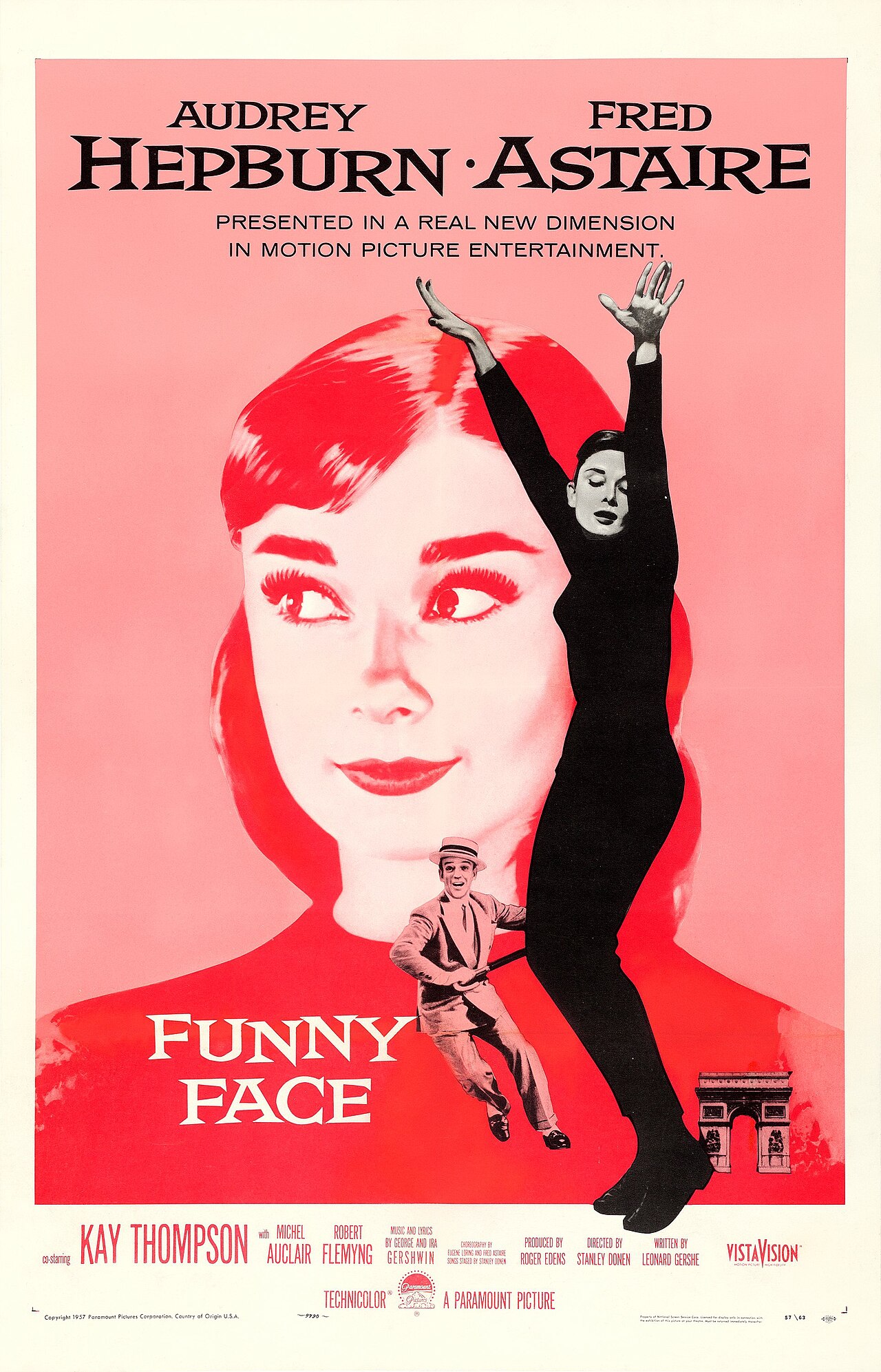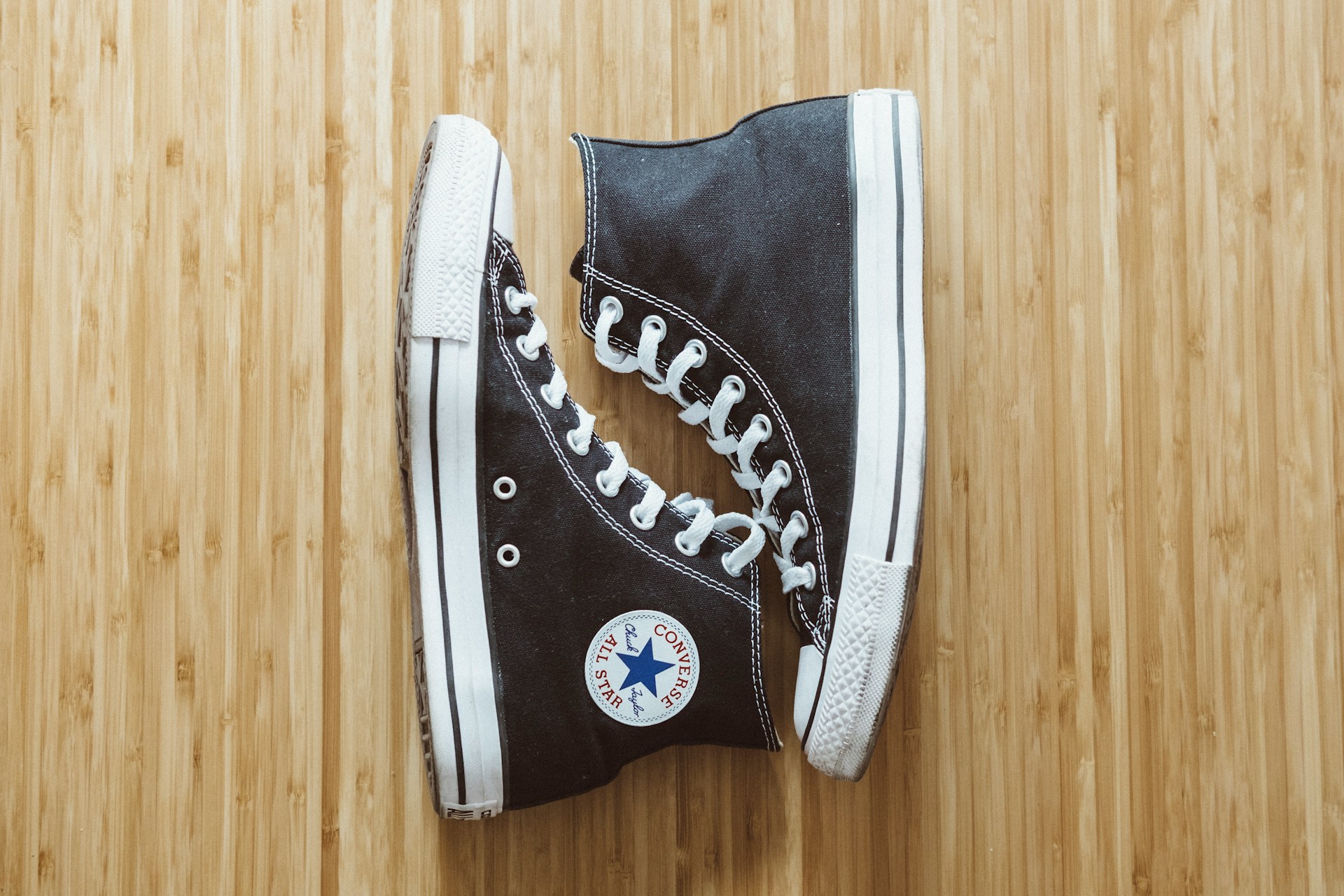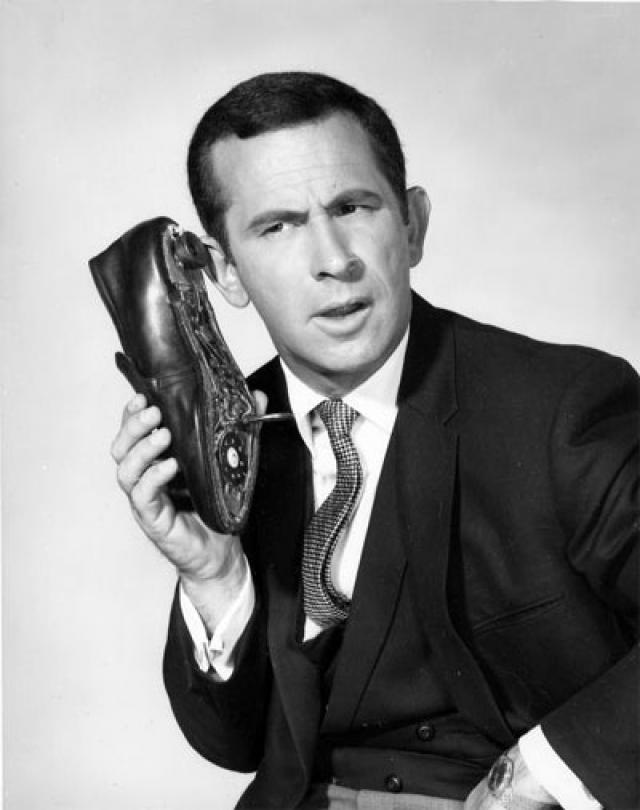Most people have favorite movies or TV shows. Many times the viewers of the most popular shows like to emulate the things shown onscreen – including language, fashions, and hairstyles. There have been many incidences in the video world where very noticeable and even iconic shoes became part of a raging fad.
The iconic shoes on films and television could range from loafers to dress shoes to sneakers. In the 1980s, a large portion of the shoes seen in movies were either Nike or Adidas, though these were not the only brands represented. Shoe fashion has been sometimes been dictated by what we see on the movies and television. Let’s take a look below to see just how much influence there’s been through the ages:
Iconic Pair of Black Loafers (1957)
(Pictured above)
Another set of well-recognized shoes is the pair worn by Audrey Hepburn in Funny Face. These were a pair of black loafers. On the men’s side of the aisle, for a similar time frame, would be Get Smart’s shoe phone – arguably the first “cell phone” seen in movies and on television. It’s also one that many people would have loved to have worn themselves – if it had worked.
The Ruby Red Slipper (1939)
RadioFan at English Wikipedia, Ruby slippers, CC BY-SA 3.0
Among the earliest iconic shoes would be the ones on Dorothy’s feet in The Wizard of Oz (the 1939 classic starring Judy Garland). These now-famous ruby-red slippers carried the beloved character home when she clicked the heels together three times and said, “There’s no place like home.”
Few people fail to recognize the original movie reference when they see ruby slippers. Interestingly, the book this movie was based on referred to the slippers as being silver. The director of the movie chose to change the color for several reasons. One of these was probably that ruby slippers gave off a more magical effect on the screen.
Blue Canvas Sneakers and Mr. Rogers (1969s – 2001)
Mr. Rogers’ Neighborhood showed us many blue canvas sneakers into which Mr. Rogers changed on his way to the neighborhood each episode. They looked comfortable and made us feel at home. According to many interpretations, these sneakers represented a sort of transition from one kind of life to the next. They’re quite popular as a part of nerd culture even today. There’s an animated spin-off of the Mr. Rogers show, where the cartoon tiger wears the same sneakers and sweatshirt combination.
The attraction of these blue canvas sneakers was not just in the comforting items themselves, but also in the act of sitting down to put them on. Everything about that act was predictable and familiar since every child would probably have done the same thing at some point. Hence, the sneakers make their way even into modern entertainment.
Star Wars and Intergalactic Boots (1970s and beyond)
As for the intergalactic boots, these were present in none other than the Star Wars series in the late 1970s to the early 1980s. This show featured Luke Skywalker with his “Dune Piercer 2” boots, which wrapped up to his knees in white cloth.Darth Vader’s black, militaristic boots underscore his imposing presence and alignment with the dark side of the Force. These boots are more than just costume pieces; they contribute to the visual storytelling of the Star Wars saga, helping to define the characters and the worlds they explore. As with just about every other prop on the show, these boots are also a coveted piece of merchandise for passionate fans.
Marty McFly’s Nike Air Mag from “Back to the Future Part II” (1989)
The Nike Air Mag sneakers worn by Marty McFly in “Back to the Future Part II” are a quintessential piece of cinematic and sneaker culture. Designed with a futuristic vision in mind, these shoes featured a self-lacing mechanism and light-up components that captured the imagination of audiences and sneaker enthusiasts alike.
The release of the Nike Air Mag in limited quantities years after the film premiered turned them into a highly sought-after collector’s item, blending nostalgia with cutting-edge sneaker technology. Nike’s eventual real-life release of the Air Mag, complete with self-lacing technology, demonstrated the lasting impact of the film’s vision of the future. The sneaker is not only a testament to the film’s influence but also a symbol of the evolution of technology and fashion intersecting in popular culture.
Carrie Bradshaw’s Manolo Blahniks from “Sex and the City” (1998-2004)
Carrie Bradshaw’s Manolo Blahnik shoes, particularly the blue satin Hangisi pumps with a crystal buckle, became emblematic of her character’s style and the broader fashion narrative of “Sex and the City.” These shoes are more than just footwear; they are a symbol of luxury, femininity, and the complexities of love and relationships explored in the series. The Manolo Blahnik brand itself was catapulted to new heights of popularity due to its frequent mentions and appearances on the show.
Carrie’s attachment to her Manolo Blahniks reflects her character’s love affair with New York City, her personal struggles and triumphs, and the inseparable link between fashion and identity. The iconic scene in which Mr. Big proposes to Carrie with a blue Manolo Blahnik shoe instead of a traditional ring encapsulates the unique blend of romance, fashion, and personal expression that defined the series.
Rocky’s Converse Chuck Taylor All Stars from “Rocky” (1976)
In “Rocky,” Sylvester Stallone’s character, Rocky Balboa, trains in Converse Chuck Taylor All Stars, a choice that underscored the character’s working-class roots and the gritty, underdog spirit of the film. The Chuck Taylors, with their simple and versatile design, were an affordable and popular shoe choice that resonated with the film’s theme of making the most out of what you have.
Rocky’s use of these sneakers during his intense training sessions, including the iconic scene where he runs up the steps of the Philadelphia Museum of Art, helped cement the Chuck Taylor All Stars as a symbol of perseverance, determination, and the pursuit of greatness against all odds. This further solidified the shoe’s legacy in both sports and pop culture.
Forrest Gump’s Nike Cortez from “Forrest Gump” (1994)
Forrest Gump’s Nike Cortez sneakers are more than just footwear in the film; they’re a narrative device that signifies Forrest’s journey through life. Gifted to him by his beloved Jenny, these sneakers are on Forrest’s feet during pivotal moments, including when he embarks on his impromptu cross-country run. The simple, classic design of the Nike Cortez became synonymous with the character’s innocence and endurance. This product placement turned the Nike Cortez into a cultural icon, reviving its popularity and associating it with Forrest’s determination, resilience, and the idea that “life is like a box of chocolates.”
The Hoverboard Shoes from “Back to the Future Part II” (1989)
In “Back to the Future Part II,” Marty McFly, played by Michael J. Fox, uses a pair of futuristic sneakers in conjunction with his iconic hoverboard. While the movie itself does not specifically highlight “Hoverboard Shoes,” the futuristic self-lacing Nike Mag shoes Marty wears became instantly recognizable. These shoes represented the 1980s vision of the future, blending technology with everyday life in a way that captured the imagination of audiences worldwide.
The self-lacing feature, in particular, became a symbol of the innovative future we all dreamed of. Nike eventually brought life imitating art into reality by releasing a version of the shoes with self-lacing technology, making them a coveted item for sneaker collectors and fans of the franchise.
Uma Thurman’s Onitsuka Tiger sneakers from “Kill Bill” (2003)
Uma Thurman’s Onitsuka Tiger sneakers are more than just a pair of shoes; they are a symbol of the film’s unique aesthetic, the character’s journey, and the impact of cinematic choices on fashion and pop culture. These sneakers embody the spirit of The Bride: resilient, relentless, and unmistakably stylish. Their significance extends beyond the screen, influencing fashion trends and the portrayal of female characters in action cinema, making them an enduring symbol of empowerment and style.
Cinderella’s Glass Slippers
Cinderella’s Glass Slippers are one of the most iconic symbols in fairy tales and cinema, representing purity, transformation, and the essence of true love. These magical shoes are not just accessories; they are key to Cinderella’s destiny and have become a cultural symbol of hope and dreams coming true. These Glass Slippers transcend their role as mere objects within a fairy tale to become enduring symbols of hope, transformation, and the pursuit of one’s true self. They remind us that beauty and elegance come from within and that genuine love sees through all disguises. The slippers continue to inspire and resonate with people of all ages, making them a timeless emblem of fairy tale magic and the power of dreams.
Maxwell Smart in Get Smart
In “Get Smart,” the iconic shoe to remember is Maxwell Smart’s Shoe Phone. This piece of spy gear is more than just footwear; it’s a symbol of the show’s unique blend of espionage and comedy. Maxwell Smart, portrayed by Don Adams, frequently used this covert communication device, housed within his shoe, to contact his headquarters. The Shoe Phone became one of the most memorable gadgets from the 1960s television series, embodying the era’s fascination with spy technology and the burgeoning field of personal electronics, albeit in a humorous and exaggerated way. It’s a prime example of how a shoe was not just a shoe in film and television but could also serve as a whimsical and inventive plot device.
80s Iconic Featured Shoes
Not surprisingly, the 1980s brought a variety of brand name footwear to the big screen. These included the following:
- Jeff Spicoli’s black and white checkered Vans Slip-Ons in Fast Times at Ridgemont High
- Kyle Reese’s Nike Vandals in The Terminator
- Pee-Wee Herman’s white tassel loafers
- Teen Wolf’s Adidas Tourneys
- Brian Johnson’s Nike Internationalists in The Breakfast Club
- Ripley’s Reebok Alien Stompers in Aliens
- Nike Air Force IIs in Big
90s and Beyond Iconic Featured Shoes
Even after the iconic fashion decade that was the 80s, the 90s and beyond had its fair share of iconic shoes as well:
- Aeon Flux introduced a very handy wedge shoe that doubled as a container for any number of useful items
- Forrest Gump’s Nike Cortez sneakers in the 1994 movie of the same name were displayed as the ultimate running shoe. This uses a major part of the story as a sort of advertisement campaign, as the main character ran a lot throughout the movie.
- Captain Jack Sparrow, in The Pirates of the Caribbean, sported shiny black pirate boots with wide flared cuffs. Pirate costumes hardly seem proper without boots like Captain Jack’s.
- Doctor Who’s Tenth Doctor, played by David Tennant, brought us Converse shoes paired with a tailored suit. His cream trainers with red stripes just above the sole are seen by fans as a symbol of the show. He also wore red high-top Converse shoes in other episodes. Needless to say, these are also very popular among fans.
- Katniss Everdeen, in The Hunger Games, wore dark brown lace-up boots. If fans are still looking for these boots, they are made by the Frye Company under the style name “Melissa Tall Lace.”
Shoes as Part of Stories
The appearance of several iconic shoes in movies and TV shows might be random at times, but they mostly symbolize many aspects of the story. In fact, sometimes the shoes are instrumental in taking the plot forward. Dorothy’s ruby slippers are a prime example, but so is the single sandal in the classic Jason and the Argonauts. Here, King Pelias is warned against a man who wears just one sandal.
Shoes also become part of a smaller sub-plot in the popular 1995 movie Jumanji, starring Robin Williams. Young Alan Parrish ruins a prototype shoe early on in the movie. Many fans might have forgotten this little detail, but it was actually this act that led to the series of events in the whole plot. This is actually what Robin Williams’ character has to reverse in order to put things right.
Conclusion
Looking at the myriad of examples above, one may conclude that shoes definitely play a huge role in many movies and shows. They’ve become symbols of fandom, represented popular characters, and even provided pivotal points for story plots. With shoes being such an important part of our everyday appearance and screens retaining their influence, we can look forward to similar trends in the future as well.




